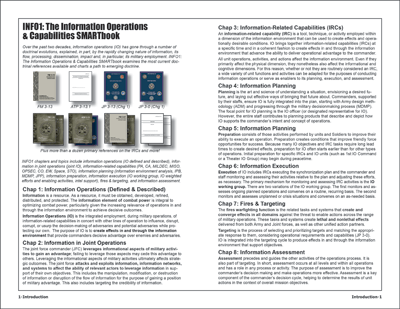Editor’s note (2024): Based on changes to joint information doctrine, Army forces will no longer use the terms information operations (see Information Advantage), information-related capabilities (see information capabilities), or information superiority. A significant joint doctrinal change is the transition from joint information operations (IO) to operations in the information environment (OIE).
See our NEW articles on Information Advantage, Information Activities, Information Capabilities, and Operations in the Information Environment (OIE).
Information Operations (IO) is the integrated employment, during military operations, of information-related capabilities in concert with other lines of operation to influence, disrupt, corrupt, or usurp the decision-making of adversaries and potential adversaries while protecting our own (JP 3-13).

Over the past two decades, information operations (IO) has gone through a number of doctrinal evolutions, explained, in part, by the rapidly changing nature of information, its flow, processing, dissemination, impact and, in particular, its military employment. INFO1: The Information Operations & Capabilities SMARTbook examines the most current doctrinal references available and charts a path to emerging doctrine.
Breaking down the definition into constituent parts helps to understand its meaning and implications for land forces:
Information Operations (IO) is the…
Integrated Employment of Information-Related Capabilities (IRCs)…
IO brings together Information-Related Capabilities (IRCs) at a specific time and in a coherent fashion to create effects in and through the information environment that advance the ability to deliver operational advantage to the commander. While IRCs create individual effects, IO stresses aggregate and synchronized effects as essential to achieving operational objectives.
During Military Operations…
Army forces, as part of a joint force, conduct operations across the conflict continuum and range of military operations. Whether participating in security cooperation efforts or conducting major combat operations, IO is essential during all phases (0 through V) of a military operation.
In Concert with Other Lines of Operation…
Commanders use lines of operations and lines of effort to visualize and describe operations. A line of operations is a line that defines the directional orientation of a force in time and space in relation to the enemy and that links the force with its base of operations and objectives (ADRP 3-0). Lines of operations connect a series of decisive points that lead to control of a geographic or force-oriented objective. A line of effort is a line that links multiple tasks using the logic of purpose rather than geographical reference to focus efforts toward establishing operational and strategic conditions (ADRP 3-0). Lines of effort are essential to long-term planning when positional references to an enemy or adversary have little relevance. Commanders may describe an operation along lines of operations, lines of effort, or a combination of both. Commanders, supported by their staff, ensure information operations are integrated into the concept of operation to support each line of operation and effort. Based on the situation, commanders may designate IO as a line of effort to synchronize actions and focus the force on creating desired effects in the information environment. Depending on the type of operation or the phase, commanders may designate an IO-focused line of effort as decisive.
To Influence, Disrupt, Corrupt, or Usurp…
IO seeks to create specific effects at a specific time and place. Predominantly, these effects occur in and through the information environment. Immediate effects (disrupt, corrupt, usurp) are possible in the information environment’s physical and informational dimensions through the denial, degradation, or destruction of adversarial or enemy information-related capabilities. However, effects in the cognitive dimension (influence) take longer to manifest. It is these cognitive effects—as witnessed through changed behavior—that matter most to achieving decisive outcomes.
The Decision Making of Enemies and Adversaries…
While there are differences among the terms adversaries, threats, and enemies, all three refer to those individuals, organizations, or entities that oppose U.S. efforts. They therefore must be influenced in some fashion to acquiesce or surrender to or otherwise support U.S. national objectives by aligning their actions in concert with commanders’ intent. [The joint phrasing “adversaries and potential adversaries” is revised to “enemies and adversaries” to better align with Army terminology.]
While Protecting Our Own…
Friendly commanders, like enemy and adversary leaders, depend on an array of systems, capabilities, information, networks, and decision aids to assist in their decision making. Gaining operational advantage in the information environment is equally about exploiting and protecting the systems, information, and people that speed and enhance friendly decision making, as it is about denying the same to the threat.
 This article is an extract from “INFO1: The Information Operations & Capabilities SMARTbook (Guide to Information Operations & the IRCs)” by The Lightning Press. Download a free PDF sample and learn more at: “INFO1: The Information Operations & Capabilities SMARTbook (Guide to Information Operations & the IRCs).”
This article is an extract from “INFO1: The Information Operations & Capabilities SMARTbook (Guide to Information Operations & the IRCs)” by The Lightning Press. Download a free PDF sample and learn more at: “INFO1: The Information Operations & Capabilities SMARTbook (Guide to Information Operations & the IRCs).”
Browse additional military doctrine articles in our SMARTnews Blog & Resource Center.
About The Lightning Press SMARTbooks. Recognized as a “whole of government” doctrinal reference standard by military, national security and government professionals around the world, SMARTbooks comprise a comprehensive professional library. SMARTbooks can be used as quick reference guides during operations, as study guides at education and professional development courses, and as lesson plans and checklists in support of training. Browse our collection of Military Reference SMARTbooks to learn more.













































